The Apple iPad Review (2012)
by Vivek Gowri & Anand Lal Shimpi on March 28, 2012 3:14 PM ESTThe Display: In Practice
I remember a time when 3D games stopped looking good to me. It didn't matter what what id, Epic or Crytek would do, I just came away unimpressed while all of my friends oohed and ahhed. It wasn't because these developers and artists were doing a bad job, it was because I was spoiled by the 3D tech demos ATI and NVIDIA would show me on a regular basis. Not burdened by the realities of running a game company, including not having to build something that would run on every PC, not just the top 1%, ATI and NVIDIA would regularly share with me the absolute best of what could be done on the world's fastest GPUs. They were truly pushing the limits with these tech demos, they always looked amazing, but they ruined all actual games for me. Nothing ever looked as good as these demos and thus I was never really impressed with the visuals of any game I saw. I always came to expect better looking visuals and the best a game developer could deliver was on par with my expectations. Never could a developer exceed them.
I feel like Apple and other companies pushing the display industry forward have done something similar to the visual impact of a good display. I'm rarely blown away by a display, I've just come to expect good ones and I'm sorely disappointed when I encounter bad ones. The Retina Display on the new iPad is good, spectacular, amazing, sharp, great even, but it's what I've come to expect.
There's been a lot of debate online among reviewers and users alike about just how good, subjectively, the new Retina Display is. I feel like the cause for the debate boils down to just where your expectations are. If you're used to using the bargain basement TN panels that this industry is littered with, then you will be blown away by the iPad's Retina Display. If, however, you're surrounded by good displays—perhaps even those used in other Apple products—you'll like the new display, but you'll be grounded in your reaction to it.
Assuming you don't have absolutely perfect eyesight, you'll have trouble resolving individual pixels on the new Retina Display. If you're used to this because of your iPhone 4/4S, HTC Rezound or other amazingly high-density display, the experience on the new iPad will be similar, just on a larger scale.
To the left we have the original 1024 x 768 panel, and to the right we have the new Retina Display. At this distance you can still identify individual pixels, an ability that quickly vanishes at normal viewing distances. The Music app icon is an even better example of what you gain from the newer display as it has more high contrast edges that appear more aliased on the 1024 x 768 panel:
If we take a few (or an order of magnitude) more steps closer to the display and put it under the microscope we can get an even better appreciation for exactly what Samsung (and Apple's other display vendors) have done with the creation of this panel. Below are shots at 50x magnification of the display from the iPad 2, new iPad, ASUS TF Prime and iPhone 4S, organized from lowest to highest DPI:
![]()
Apple iPad 2, 1024 x 768, 9.7-inches
![]()
ASUS Eee Pad Transformer Prime, 1280 x 800, 10.1-inches
![]()
Apple iPad Retina Display (2012), 2048 x 1536, 9.7-inches
![]()
Apple iPhone 4S, 960 x 640, 3.5-inches
What you're looking at here are shots of the three subpixels for each pixel. Subpixel shapes will vary by panel type/manufacturer (hence the iPhone 4S vs. iPad subpixel structure), but the increase in density is tremendous.
I hate the term "painted on" because it gives the impression, at least to me, of limited separation between the viewer and the object as you would have with a piece of paper. Despite the very shallow gap between the outermost glass and the display stack itself, you can still tell that you're looking at a screen with the new iPad. Perhaps it's because of the reflections in the glass or the lack of tactile feedback convincing you that you are still looking at a virtualized interface, but the Retina Display does not break down the barrier of reality. It's always dangerous when using hyperbole to speak about a display as good as the iPad's. Get too excited in your description and you're bound to disappoint those whose expectations are simply too high. The iPad's Retina Display is stunning but the best way I'd describe it is this: the Retina Display is the type of display a $500+ tablet should come with.
iOS is often applauded for maintaing a smooth UI frame rate during animations like screen swipes. The screen on the new iPad delivers delivers a similarly seamless experience, but with regards to stationary content. Icons on your home screen look permanent, in place and, I hate to say it because nothing ever truly is, perfect.
Text is always sharp and extremely legible. You won't get the minimal fatigue you get from an e-ink display, but once you do have the versatility of a full blown tablet with the iPad.
Remote desktop apps stand to benefit tremendously from the new iPad's Retina Display, particularly if you're remotely accessing a very high resolution desktop. The image below is what my 2560 x 1440 desktop looks like, remotely accessed from an iPad 2:
Text is extremely aliased, basically illegible. I can see everything on a single screen but I can't really make out much of what I'm looking at.
Here's the same remote desktop app for Android running on an ASUS Transformer Prime at 1280 x 800:
Here we have a tangible improvement, but still not tremendously better than the iPad 2. Now let's look at the desktop on the new iPad:
I can actually read the contents of IMs I'm receiving, I'm still going to want to zoom in to actually do anything but even zoomed in the crispness of everything is just so much better. This is a functional, dare I say productive use of the new Retina Display.
Mouse over the links above to see a crop of me remotely accessing my desktop from the three tablets. There's a huge improvement in how legible the remotely accessed text is on the Retina Display.
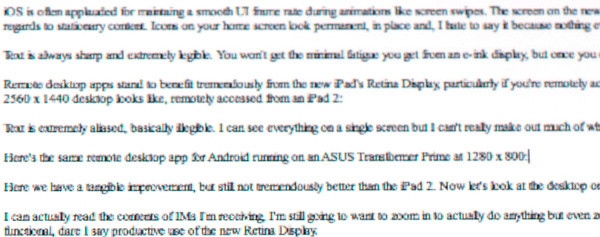
| Apple iPad 2 | Apple iPad (3rd gen) | ASUS TF Prime |
Other examples of very small text on a high-contrast background are similarly impressive. Web pages are generally better behaved than remotely accessing a very high-resolution display on an iPad, but the same principles apply:
With more pixels available to map to, small fonts retain their detail rather than turn into a jagged mess. Hover over the links below to see roughly the same paragraph of text from our retail Radeon HD 7870 review on the iPad 2, new iPad and ASUS Transformer Prime:
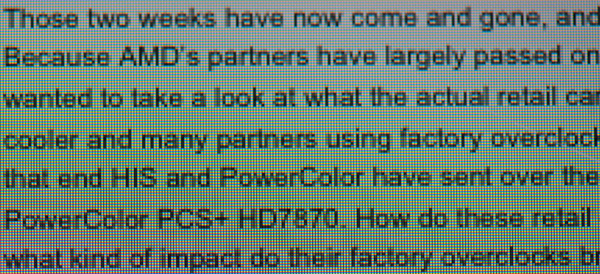
| Apple iPad 2 | Apple iPad (3rd gen) | ASUS TF Prime |
| original | original | original |
Keep in mind that you are limited to the resolution of the content you're viewing, which is particularly a problem on the web. The majority of displays fall somewhere between the 1366 x 768 and 1680 x 1050 range, and the majority of websites are designed to be fixed width at no more than 1200 pixels wide. As a result, images embedded on these websites are relatively low resolution compared to the iPad's display. We'll have to see a fairly large shift in display resolution across the board to really push the web towards embedding higher resolution photos and images, but it'll be a point of frustration.
Safari's 2MP JPEG Limitation
There's another present limitation in mobile Safari for iOS: JPEG images larger than 2.097MP are automatically downscaled for display, even on the new iPad. To test behavior I created a few images at varying resolutions and listed the displayed resolution on the iPad:
| Mobile Safari (iOS) JPEG Limits | |||||||||
| Image | Native Height | Native Width | iPad H | iPad W | Ratio | Native MP | iPad MP | ||
| Full | 4256px | 2832px | 1064px | 708px | 1:4 | 12MP | 0.75MP | ||
| 3000px | 3000px | 1996px | 1500px | 998px | 1:2 | 6MP | 1.5MP | ||
| 2000px | 2000px | 1331px | 1000px | 666px | 1:2 | 2.66MP | 0.67MP | ||
| 1600px | 1600px | 1065px | 1600px | 1065px | 1:1 | 1.70MP | 1.70MP | ||
As soon as you pass the 2.097MP threshold, mobile Safari will reduce the horizontal or vertical resolution (or both) of the image being rendered by an integer factor until the resulting image is below the threshold. The limit is purely resolution based. Apple documents the limit is 2MP however I was able to create images that were slightly bigger without triggering the downsample. The maximum decoded JPEG resolution according to Apple is 32MP.
The downscaling made sense when the iPad had a 1024 x 768 display, but it's now time for a Safari update lifting the restriction to properly support the new iPad.
Note that this limit doesn't apply to GIFs, PNGs or TIFFs, only JPEGs. Apple claims that for these other file formats you're limited to a max decoded size of 3MP on iDevices with less than 256MB, or 5MP on 512MB iDevices, although you'll notice a 64MP PNG in the image above being rendered at what appears to be full resolution.












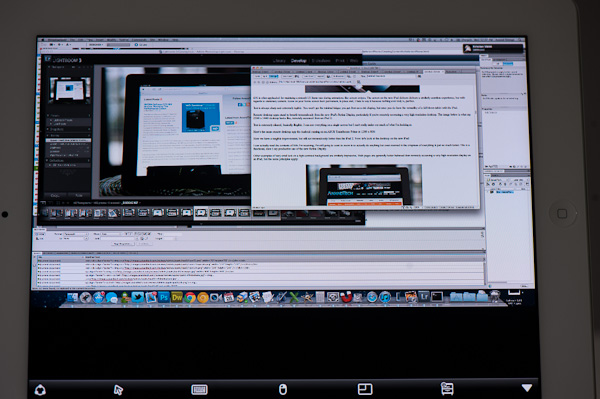

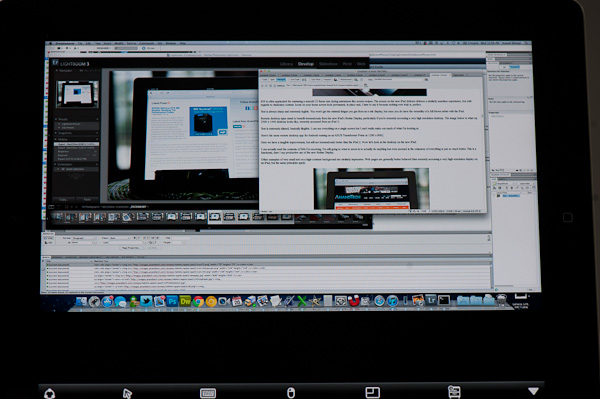

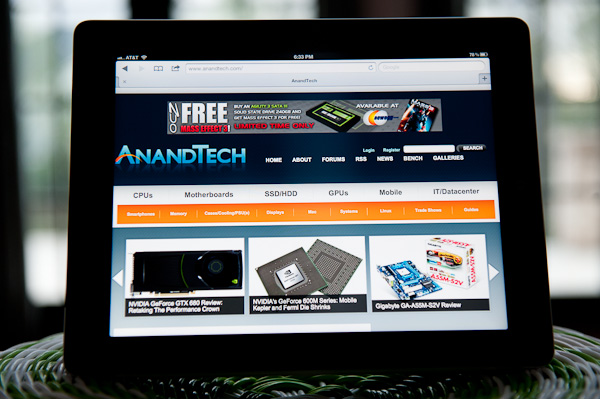



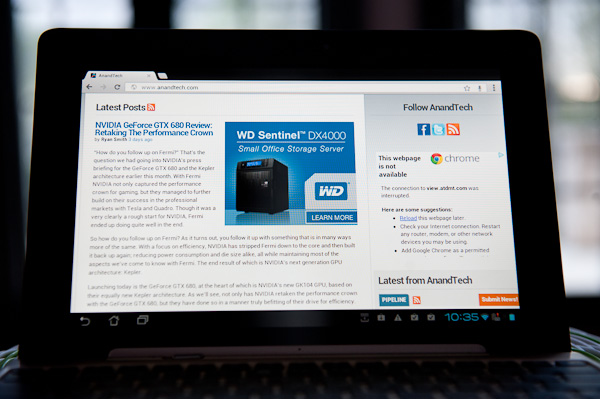









234 Comments
View All Comments
mr_ripley - Friday, March 30, 2012 - link
It's a shame some people argue that against the workers when over a hundred of them have committed suicide over the working conditions. How can you still say that they are being offers a better deal here??On the other hand, it is also unfair that Apple is being singled out here. The world of Chinese manufacturing is a dirty one and all major corporations have a part in it. I'd trust Apple over most other companies to make a difference in that regard, and I'm happy to see something is being done in that regard. Ever heard McDonalds CEO touring the slaughterhouse of the meat packing companies??
name99 - Friday, March 30, 2012 - link
Reporting suicides as a number not as a rate shows you to be either a fool or a deliberate liar. How many people, over how many years, comprise the pool from which this suicide number is drawn? Everything I have read says that the actual suicide rate is not only lower than the average rate for China, it is lower than the average rate for the US.mr_ripley - Friday, March 30, 2012 - link
In 2010, 18 workers attempted sucide, 14 succeeded. To me even one in a whole year is not acceptable. If you think that is ok I hope that statistic turns out to be you!!name99 - Saturday, March 31, 2012 - link
The argument was NOT that suicide is a tragedy, it was a claim that FoxConn employees specifically tied to Apple production have such lousy lives that they commit suicide in higher numbers that other people around the world.You have done NOTHING to prove this claim; all you have done is bring up a very different issue.
mr_ripley - Saturday, March 31, 2012 - link
There is no disputing the fact that these deths are related to working conditions. I'm pretty sure this has been well established and documented. However, I did say in my previous post that Apple is unfairly singled out. It could have been any other company.Comparison between suicide rates is irrelevant. Higher sucide rates elsewhere does not justify this problem. Again the fact remains that many people have died and it is directly related to the working conditions.
Apple happens to be in a position to directly influence their lives and make it better, after all they profit in billions from the work these people do. Corporations typically place little value over human life and living conditions (IBM sold equipment to the Nazis to track the Jews in concentration camps). Somehow, I feel Apple is different.
doobydoo - Sunday, April 1, 2012 - link
Dude, sorry but you're talking no sense at all.First of all, pretty much any product you want to buy, electronics wise, uses parts from China where conditions are far worse on average, than Apples factories. So if you actually factored working conditions into the product review, it would look favourable for Apple.
Secondly, your argument that comparison between suicide rates is irrelevant, is absurd. Higher suicide rates where legislation is such that no jobs suffer such terrible conditions that suicide is the only option, such as is the case here, prove that even if working conditions are refined, you still get some depressed people. Your argument, therefore, is with the people who committed suicide. You say it is 'directly related to the working conditions' but where have you evidenced this, at all? You simply haven't. The fact that the suicide rates at Apple factories are lower than some American ones further backs up my point on this.
Every company is in a position to change lives and make them better. You too, are in a position to do this. But guess what. You, just like companies, can do WHATEVER YOU LIKE with your OWN MONEY and have NO OBLIGATION WHATSOEVER to solve the worlds problems. Apple already has amongst the best conditions of factories in China. The amount of profit they make is absolutely irrelevant, if you say Apple should be putting money into this then a lot more manufacturers should also put a lot more money into this. It's very easy to decide what other people 'should' do with their money now, isn't it?
Corporations don't have to adhere to moral values - they are not people. They are there solely to make money. Nothing else. Don't confuse them with people. And I hope you donate every single spare penny to charity and spend every spare second of your time working to build homes in the 3rd world. Oh wait, you're on here crying that other people should do it instead.
Get a hold of yourself you illogical fool.
mr_ripley - Sunday, April 1, 2012 - link
Like I have said before it is a shame some people argue with great zeal against others who are suffering and devalue human life. Fortunately, Tim Cook is not one of them.If scores of people killing themselves citing poor working conditions is not enough proof what is? If your claim that there are work environments in America that have higher suicide rates because of working conditions is true that needs to be investigated as well and rectified.
You give charity to people who are in need and cannot earn for themselves. If you think giving someone fair amount of compensation for hard work is charity you are delusional.
If working in those factories is such a pleasent experience I suggest you try it out for yourself. Maybe the experience might broaden your perspective.
Although, I don't see the point I will attempt to educate you. Legally, a corporation is considered as a person, that is right just like a live human being. Regardless of that corporations are run by people and actions of a corporation reflect upon the morality of the people running them.
I will stop here as there is no point in continuing but you can respond with more insults and accusations of what I do or have done which frankly is no concern of yours.
PeteH - Monday, April 2, 2012 - link
I've not seen a single report of people killing themselves and citing "poor working conditions" as the reason. Can you provide a link?There have been reports of people killed because of unsafe working conditions, but that's a different issue. Maybe you're confusing the two.
mr_ripley - Tuesday, April 3, 2012 - link
Here's a Wikipedia link: you can read some of the circumstances and judge for yourself.They may not have said it in so many words but it is clear they were unhappy with ther work environment.
Imagine your boss coming and beating you up because you lost an iPhone prototype!!!
mr_ripley - Tuesday, April 3, 2012 - link
http://en.wikipedia.org/wiki/Foxconn_suicides